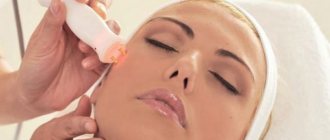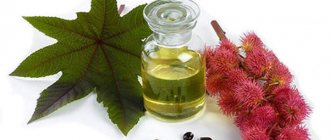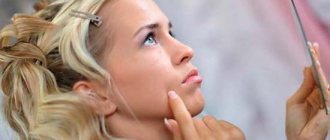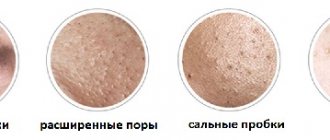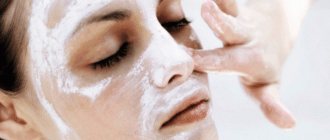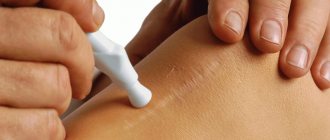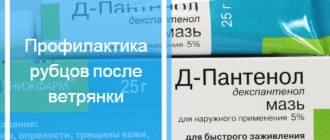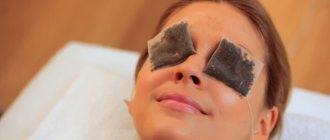Acne scars are mainly a consequence of improper care for problem skin and bring a lot of aesthetic discomfort. If the defect is pronounced and cannot be corrected using usual home methods, experts advise resorting to professional salon procedures. Already after the first visit to a cosmetologist, the effect will be noticeable.
For people interested in the question of how to remove acne scars, there are also some useful tips and methods to cleanse the skin and even out the microrelief. But it is worth noting that home remedies will only be effective for minor superficial defects, but they are unlikely to cope with deep and old scars.
Causes of Acne Scars
The main reason why scar defects form on the skin is improper care of problem skin.
Some patients neglect basic hygiene rules, which leads to disruption of the functioning of the sebaceous glands, the formation of deep inflammatory foci, which, after opening, do not heal for a long time, and scar tissue forms in their place.
Other common causes of acne scars include:
- Self-extrusion. It is not always possible to squeeze out a deep pimple on your own, as a result of which some of it remains under the skin. And if a person does not wash his hands before the operation and introduces an infection into the wound, an inflammatory complication often develops, which leads to uneven healing of the wound and scar formation.
- Incorrect treatment of acne. Acne, located deep under the skin and often inflamed, requires proper, professional treatment. If therapy is untimely or completely absent, the risk of developing complications, accompanied by the formation of various cosmetic defects on the face, increases.
- Attachment of a fungal infection. Fungal infections of the skin cannot always be diagnosed in a timely manner, which is why inflammatory processes progress. Inadequate treatment of this pathology often leads to inflammation and scarring of the connective tissue.
- Direct exposure to ultraviolet rays. If there is acne on the skin, the pigment substance melanin always accumulates in excess in areas prone to inflammation. When exposed to sunlight, melanin-rich acne becomes even darker, causing dark spots and scars.
Chest acne treatment
Treatment of acne on the chest requires an integrated approach, which includes topical agents and systemic drugs. In some cases, visiting cosmetology centers for hardware procedures is indicated. Traditional methods are an additional help that helps get rid of pain and discomfort.
Topical products
There are dozens of creams and ointments on the market designed to treat acne. Depending on the diagnosed cause, the remedy is selected.
External preparations based on:
- Antibiotics;
- Benzoyl peroxide;
- Alapalena;
- Azelaic acid;
- Salicylic acid;
- Zinc acetate.
Ointments, gels and lotions reduce the appearance of acne, normalize the production of skin secretions, improve its composition, prevent scarring, and dry out excessively oily skin.
Systemic drugs
Severe forms of the disease cannot be treated with external remedies alone. In this case, treatment for acne in the chest area involves taking oral tablets.
Basically, they resort to 3 groups of drugs:
- Antibiotics. Allows you to cope with infectious agents and reduce inflammation caused by bacteria. Dermatologists prefer new generation medications that have a gentle effect on the human body and do not disturb the intestinal microflora. However, antibacterial drugs differ in their list of contraindications, so their inclusion in therapy is possible on the recommendation of the attending physician.
- Combined oral contraceptives. They are used to treat acne in women in cases where the disease is caused by hormonal imbalance. For such disorders, birth control pills or pills are prescribed to normalize hormonal levels. It is strictly not recommended to take them on your own; side effects are possible, and the exact dosage is selected based on test results.
- Retinoids. The most powerful drugs indicated for the treatment of extremely severe acne. In most cases, they are intended to treat men. They have a significant list of contraindications and side effects, so the therapeutic course requires regular checks of the patient’s health.
Traditional methods
It should be noted that traditional medicine also has in its arsenal many methods that can be used in addition to drug therapy. Essential oils, whose healing properties are widely popular in the East, have been undeservedly forgotten. A couple of drops of lavender or tea tree essence, diluted in light carrier oils, kill bacteria and reduce inflammation.
Aloe juice has proven itself well. The simplest way is to squeeze the gel from a freshly cut leaf directly onto the formation twice a day. Ordinary oatmeal has beneficial properties. A few handfuls of flakes should be placed in a warm bath and allowed to brew. During the procedure, it is recommended to take a handful of the pulp and wipe the affected areas of the chest.
A budget-friendly remedy for getting rid of inflamed papules is baking soda. Has a drying effect and reduces redness.
To prepare the medicinal paste you need:
- Mix 2 tablespoons of baking soda and water;
- Add a teaspoon of juice squeezed from lemon;
- Apply to acne elements and wait a quarter of an hour;
- Rinse thoroughly and dry the skin.
For dry and sensitive skin, lemon juice should be avoided. The composition must be applied daily until the ulcers and inflamed nodules are completely eliminated.
Cosmetology
Modern technologies make it possible to treat acne in salons, and quite effectively.
Experts in the field of cosmetology recommend resorting to the following procedures to get rid of acne elements.
- Laser therapy. The targeted laser action destroys bacteria without affecting healthy tissue;
- Phototherapy. A beam of light penetrates the skin and stimulates local metabolism, and also eliminates dead skin particles;
- Chemical and ultrasound peeling. Designed for deep cleansing of the skin and elimination of acne elements and pathogenic bacteria;
- Ozone therapy. Injections with a mixture that suppresses the inflammatory process.
Additional recommendations
If you have rashes in the chest area, you need to follow some tips that will help cure the disease or get rid of pinpoint rashes faster.
They are:
- Allocating additional time for rest, which increases the body’s protective properties;
- Revising the menu, excluding fried, fatty and sweet foods, and adding fresh fruits and vegetables, yoghurt, kefir, cottage cheese, lean meat, fish, cereals;
- Hardening to strengthen the immune system and improve overall metabolism;
- Wearing underwear only from natural materials;
- Using antibacterial cleaning agents while showering or bathing.
Types of scars and scars after acne
Acne scars come in the following varieties:
- Atrophic. The main reason for its occurrence is a deficiency of collagen in tissues. Such defects form in places where multiple rashes are localized, affecting the deep layers of the epidermis. Externally, an atrophic scar looks like a depression in the skin, brings a lot of aesthetic discomfort, and does not respond well to conservative treatment.
- Normotrophic. Outwardly they resemble spots that become more noticeable as the ambient temperature decreases. Such scars are flush with the skin.
- Hypertrophic. The main cause is excessive synthesis of collagen fibers. Hypertrophic scars are especially noticeable because they rise above the surface of the skin.
- Keloids. Outwardly they resemble hypertrophic ones, the reason for their appearance is the proliferation of connective tissues. As a rule, keloid scars are red in color and over time can increase in size, itch and cause discomfort. This type of scar is the least susceptible to cosmetic correction.
Considering how the defect looks externally, the following types of scars and acne scars are distinguished:
- Chipped. They resemble deep depressions, the edges of which seem to be chipped.
- Rectangular. Such scars are generally shallow, have a large area of distribution, and have chipped edges, the angle of which is straight.
- Rounded. The edges of the scar smoothly transition into healthy skin.
- Convex. They rise above the surface of the epidermis and have a smooth or rough surface.
Scars on the back
Hypertrophic raised scars most often form on the back and chest. They rise above the surface of the skin and may have a darker or lighter color. Scars do not extend beyond the original lesion and are easily corrected because they contain little scar tissue.
Welts and scars on the legs
Acne scars are least likely to occur on the lower extremities. This is explained by the fact that the skin on these parts of the body is denser and rougher than on the face, neck, and décolleté. A scar on the leg often occurs after squeezing out a pimple, infection of the wound and progression of inflammatory bacterial processes.
If the treatment of the complication is incorrect or untimely, the tissue in these places begins to scar.
What causes acne on the chest?
Rashes on the chest are often accompanied by the appearance of acne on the back. Acne is common not only to adults, but also to newborn children and adolescents. However, in infants, the disease occurs only on the head; a rash on the torso indicates an allergic reaction.
In adolescence, acne is a relatively normal process caused by changes in the maturing body. Most often the rash is localized on the face, but sometimes it spreads throughout the body, affecting the shoulders, chest and back.
Medical experts identify the following causes of chest acne in adults:
- Strong emotional experiences, stress, anxiety and depression;
- Tendency to dermatological diseases;
- Infection of the body;
- Excessive adherence to detergents and care products containing aggressive components;
- Allergic reaction to drug therapy;
- Insect bites;
- Mechanical friction from clothing or jewelry;
- Hormonal imbalance;
- Pathologies of the digestive and endocrine system;
- Exposure to polluted environment;
- Increased sweating.
Acne under the chest is always caused by neglect of hygiene procedures. If women develop pimples between the mammary glands, the reason is poorly chosen underwear that blocks the removal of excess moisture. In this case, it is enough to choose a bra made from natural fabrics that will allow air to pass through.
What is the difference between acne signs and scars?
Acne is an inflammatory skin disease that develops against the background of dysfunction of the sebaceous glands and a decrease in the bactericidal properties of the epidermis. The sebaceous glands, under the influence of internal or external factors, produce a specific secretion in excess, which is not fully excreted, but remains in the sebaceous sac. The composition contains dead epidermal cells, microparticles of dust and other polluting components. As a result, the pores expand, pathogenic microflora are activated, which leads to the progression of inflammatory processes and suppuration.
A person does not treat acne, ignores the rules of personal hygiene, squeezes out the contents on his own, and a more aggressive bacterial infection develops. This leads to a serious inflammatory complication that spreads to the deeper layers of the dermis, where purulent pustules form. They gradually increase in size, merge with each other, and open up. After this, scars and scars form on the surface of the epidermis, which can only be gotten rid of with the help of a plastic surgeon.
Real ways to quickly clear your face of scars in the salon
It is advisable to entrust the fight against acne scars to professional cosmetologists, who, after assessing the extent of the problem, will select the most effective treatment method. Therefore, it is extremely important to take a responsible approach to choosing a clinic and specialist, giving preference to well-established institutions that value their reputation.
How to get rid of acne scars using hardware methods?
Hardware techniques effectively combat acne scars of any degree of complexity. Modern cosmetology clinics have various effective ways to combat skin defects. The most effective are:
- Hardware peeling. Resurfacing of skin defects is provided by a special device that removes not only scars from the surface of the epidermis, but also deep wrinkles, folds, and creases.
- Plasmolifting. A popular injection technique during which the patient’s own platelet-rich plasma is injected subcutaneously. The substance triggers regenerative processes, due to which cells in problem areas are restored, and no trace remains of the scar after a pimple.
- Cryotherapy. Liquid nitrogen is used during the procedure. Under the influence of critically low temperatures, scars and cicatrices dissolve and completely disappear.
- Laser resurfacing. The laser's heat beams destroy the tissue that forms the scar. Thanks to this, the skin is smoothed and defects disappear.
- Mesotherapy. The essence of the technique is the subcutaneous administration of drugs containing hyaluronic acid. The substance stimulates the regeneration of epidermal cells. The procedure is effective for removing post-acne and deep scars formed at the site of inflamed acne.
- Physiotherapy. During the procedure, the properties of ultrasound, laser, and electric current are used. The hardware effect on the skin helps activate blood circulation, which accelerates regenerative processes in cells. Thanks to this effect, skin defects are smoothed out and become completely invisible.
Laser resurfacing.
A cosmetologist will tell you more about how to get rid of acne scars. The specialist will individually select the most effective method, taking into account the type of scars and their extent.
Darsonvalization of the face
Darsonvalization is a physiotherapeutic method, the essence of which is to influence problem areas of the skin with a high-frequency current of low strength. The procedure helps accelerate blood circulation, activate venous outflow, and accelerate regenerative processes in cells. Thanks to this effect, damaged tissues are restored, and clean, healthy skin remains in place of acne scars.
How to get rid of scars and scars after acne with medications?
Medical removal of post-acne and scars is started if the skin defects are mild, the scars are not old and their depth is small. Medicines should be prescribed only by a specialist. This is the only way to achieve a positive effect and prevent complications.
The following drugs are used to combat aesthetic defects:
- "Kontraktubeks". The active ingredients of the drug are heparin and allantonin. Activates regenerative processes in tissues, softens and resolves scars. The product is applied to the surface of the skin, the course of therapy is 4–8 weeks. After application, a slight burning sensation may occur, and 2-3 days after application, peeling appears.
- Heparin ointment. The composition includes heparin, which stimulates blood circulation and activates metabolic processes in epidermal cells. The ointment is used to remove post-acne that formed less than a year ago. The course of therapy is 4–10 weeks.
- "Dermatix". The active ingredients are silicon dioxide and organic compounds. The drug is produced in the form of a gel or silicone bandage. After application, a dense film is formed that softens the scar.
- "Panthenol". The drug, the active ingredient of which is panthenol, stimulates the processes of regeneration and cell restoration, promotes intensive skin hydration and smoothes out fresh scars. The course of therapy is 6–18 weeks.
How to get rid of scars and scars after acne at home?
Homemade masks to combat scars and acne scars
A mask of honey and cinnamon restores and smoothes the skin well:
- Combine 1 tsp. fresh honey and cinnamon powder, mix well.
- Apply to pre-cleaned skin and leave for 15 – 20 minutes.
- Rinse your face with warm water.
Removing acne scars with cosmetic paraffin and wax
The essence of the procedure is the thermal effect on the skin. After applying paraffin or beeswax to problem areas, capillaries expand and blood circulation is activated. This helps improve nutrition and regeneration of damaged tissues.
The recipe for use is simple:
- Melt wax or paraffin in a steam bath.
- Cool to body temperature.
- Apply a thin layer to the skin with a special brush.
- Leave for 35 – 40 minutes.
- Remove residues with special oil.
Paraffin mask
Propolis against acne scars
To get rid of fresh scars, it is recommended to use a propolis mask, the recipe for which is given below:
- Melt 10 g of wax and 5 g of propolis in a steam bath.
- Add 1 tbsp to the mixture. l. olive oil.
- Cool the mixture to body temperature.
- Apply to affected areas, leave for 20 minutes.
Citrus fruits against acne scars
Citrus fruit juices are rich in vitamin C, which is a powerful antioxidant. To combat scars, you can use this home method:
- Soak a cotton pad in freshly squeezed lemon or other citrus juice.
- Apply the cotton wool to the problem area and secure.
- Keep the lotion for 15 – 20 minutes.
Avocado face mask
An avocado mask has a good effect in the fight against uneven skin:
- Grind the ripe avocado to a puree consistency.
- Add 1 tbsp. l. honey and juice of ½ lemon, mix the ingredients well.
- Apply the composition to the entire face, leave for 20 - 30 minutes, then rinse with warm water.
- Apply the mask every day until the skin imperfections disappear.
Cucumber juice for the face - benefits and application
Fresh cucumber juice has bactericidal properties and also lightens darkened skin. To combat scar defects, it is recommended to use cucumber lotion:
Squeeze juice from 1 cucumber using a juicer. Wipe the liquid over your entire face morning and evening. The course of therapy is 6 months.
Green tea for face - benefits and application
Green tea contains the substance catechin, which reduces inflammation, activates regenerative processes, and helps smooth out scars and scars. For treatment, you will need used sachets, which must be applied daily to the affected areas for 30 - 40 minutes.
Milk serum for face - benefits and application
Whey contains water (about 93%), as well as the following beneficial substances:
- amino acids;
- lactose;
- fatty acid;
- bacteria;
- milk sugar;
- vitamin and mineral complexes.
These components have a beneficial effect on the condition of the skin, help smooth out the microrelief and get rid of pigmentation and shallow scar formations. To achieve a positive effect, it is recommended to apply whey to the face every morning and evening and leave for 25 - 30 minutes. Then rinse off the product with warm water.
Surgical treatment of scars
Hypertrophic and keloid scars most often require surgical treatment. They are removed using a special incision, which is then stitched with a cosmetic suture.
Deep atrophic acne scars can also be successfully treated with surgery. The modern method, subcision, shows fairly good results in this regard.
What does it consist of:
- The operation is minimally invasive and is performed under local anesthesia.
- An instrument is inserted at an angle to the scar, with which the doctor trims the dense collagen threads that attach the bottom of the scar, attracting it to the hypodermis.
- Having been freed from pathological attachment, the surface of the scar, which was previously depressed, is leveled with the general level of the skin.
After the procedure has been carried out, skin care is of particular importance. It is necessary that the void between the skin above the scar and the subcutaneous fat is filled evenly.
This process can be regulated by treating this area with a laser, which stimulates and normalizes collagen production.
Therefore, subcision is often combined with laser therapy. This method allows you to most effectively cope with the problem when the scar is deep. Subcision is great for treating chipped and oval types of acne.
How to get rid of scars and acne marks on the body?
Since there are several types of scars and acne scars, and the mechanism of their appearance may differ, the doctor selects an individual treatment regimen for the treatment of each individual case. After the examination, the doctor will decide which method is most effective for the patient and which one is better to refuse. In most cases, salon treatments are recommended. If desired, as an auxiliary therapy, you can use home remedies, the recipes of which should also be agreed upon with a specialist.
How to even out facial skin after acne?
Curing acne is much easier than dealing with the marks and scars that acne leaves behind. The main rule to follow is to use an integrated approach in the fight against skin defects. Effective ways to quickly and painlessly get rid of scar defects are salon procedures, the most useful of which are:
- laser resurfacing;
- mesotherapy;
- plasma lifting;
- ultrasonic, chemical or vacuum facial cleansing.
It is important to choose high-quality cosmetics for everyday care. It is better to give preference to products that contain substances that stimulate active cell regeneration. And also, do not forget about home remedies that are no less effective in fighting scars and scars.
The right makeup will help even out your facial skin after acne. All kinds of basic foundations, highlighters, foundations will help to perfectly disguise imperfections, make the skin smooth, even, radiant and attractive. It is advisable to choose products made from natural ingredients that do not cause irritation and the appearance of new rashes.
Homemade external remedies
If desired, you can make homemade ointments to get rid of scar formations. In terms of their effectiveness, they are no worse than ready-made pharmacy creams. Best recipes:
- You need to mix 1 tsp. honey with the same amount of ground cinnamon, and then apply the resulting thick mass to the cleansed problem areas. After 20 minutes, rinse off the product with warm water. The procedure is performed once a day, every other day.
- You need to mix 500 g of goose fat and ground Sophora japonica fruits, then steam the mixture for 4 days in a row (60 minutes every day). On the 5th day, apply the ointment to gauze and apply to the scars for 15 minutes.
- It is necessary to combine 400 ml of vegetable oil and 100 g of beeswax, and then keep the composition on low heat for 10 minutes and cool. Distribute the finished product over areas of skin with scar formations 2 times a day.
In addition, the cabbage-honey mask has good healing properties. To make it, grind the cabbage leaves in a blender and add 10 g of natural honey to the resulting pulp. Apply the product to the location of the scars and wash off with warm water after 2 hours. The procedure is performed twice a day for 3 weeks or 3 months.
Rules for caring for skin with scars and acne scars
Skin prone to rashes and scars requires special care using special cosmetics selected by a dermatologist. To prevent the appearance of new scar formations and smooth out old ones, cosmetologists advise following these rules:
- constantly moisturize the skin;
- For hygiene procedures, use only mild cleansers;
- choose the right skincare products;
- do not self-medicate in case of complications;
- Healthy food;
- monitor the water balance in the body;
- Do not squeeze or pick pimples; entrust their removal to an experienced cosmetologist.
Glycolic peeling
This type of exfoliation is based on glycolic acid, which can cleanse sebaceous ducts and rejuvenate the skin. Glycolic peeling is perfect for women over 30 who experience periodic rashes and post-acne. This procedure is superficial. It is carried out using a solution with a concentration of up to 25%. It is prescribed for problematic and oily dermis with single pimples. There is also a medium glycolic peel, which is used for serious structural changes and the presence of severe acne.
Exfoliation is carried out strictly according to a specific scheme. This takes from 20 minutes to half an hour. The procedure is performed only in winter and autumn.

